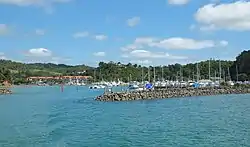Tutukaka | |
|---|---|
 Tutukaka marina | |
| Coordinates: 35°36′38″S 174°31′28″E / 35.61056°S 174.52444°E | |
| Country | New Zealand |
| Region | Northland Region |
| District | Whangarei District |
| Ward | Hikurangi-Coastal Ward |
| Electorates | |
| Government | |
| • Territorial Authority | Whangarei District Council |
| • Regional council | Northland Regional Council |
| Area | |
| • Total | 6.98 km2 (2.69 sq mi) |
| Population (June 2023)[2] | |
| • Total | 830 |
| • Density | 120/km2 (310/sq mi) |
Tutukaka (Māori: Tūtūkākā)[3] is a locality on the east coast of Northland, New Zealand, in an area commonly referred to as the Tutukaka Coast which includes Ngunguru and Matapouri.[4] The city of Whangārei is to the southwest. The residential areas of Tutukaka fringe the hills surrounding Tutukaka Harbour, which has a history as a local fishing port and hosts Tutukaka's marina. The Māori name comes from the term tūtū kākā, which means a parrot (kākā) snaring tree (tūtū).[5][6]
As the closest marina to the Poor Knights Islands, Tutukaka is the base for boat tours for diving and snorkelling in the waters around these islands, a protected marine reserve. At the peak of the busy summer months, Tutukaka's population swells from around 600 permanent residents to over 2,400.[7] A walking track leads from Tutukaka to a small lighthouse at Tutukaka Head (South Gable).
Demographics
Statistics New Zealand describes Tutukaka as a rural settlement. The settlement covers 6.98 km2 (2.69 sq mi)[1] and had an estimated population of 830 as of June 2023,[2] with a population density of 119 people per km2. The settlement is part of the larger Matapouri-Tutukaka statistical area.[8]
| Year | Pop. | ±% p.a. |
|---|---|---|
| 2006 | 519 | — |
| 2013 | 588 | +1.80% |
| 2018 | 726 | +4.31% |
| Source: [9] | ||
Tutukaka had a population of 726 at the 2018 New Zealand census, an increase of 138 people (23.5%) since the 2013 census, and an increase of 207 people (39.9%) since the 2006 census. There were 294 households, comprising 357 males and 372 females, giving a sex ratio of 0.96 males per female, with 90 people (12.4%) aged under 15 years, 75 (10.3%) aged 15 to 29, 336 (46.3%) aged 30 to 64, and 219 (30.2%) aged 65 or older.
Ethnicities were 92.6% European/Pākehā, 14.0% Māori, 1.7% Pacific peoples, 1.7% Asian, and 2.1% other ethnicities. People may identify with more than one ethnicity.
Although some people chose not to answer the census's question about religious affiliation, 59.1% had no religion, 32.6% were Christian and 1.7% had other religions.
Of those at least 15 years old, 174 (27.4%) people had a bachelor's or higher degree, and 75 (11.8%) people had no formal qualifications. 132 people (20.8%) earned over $70,000 compared to 17.2% nationally. The employment status of those at least 15 was that 276 (43.4%) people were employed full-time, 108 (17.0%) were part-time, and 15 (2.4%) were unemployed.[9]
References
- 1 2 "ArcGIS Web Application". statsnz.maps.arcgis.com. Retrieved 18 April 2022.
- 1 2 "Subnational population estimates (RC, SA2), by age and sex, at 30 June 1996-2023 (2023 boundaries)". Statistics New Zealand. Retrieved 25 October 2023. (regional councils); "Subnational population estimates (TA, SA2), by age and sex, at 30 June 1996-2023 (2023 boundaries)". Statistics New Zealand. Retrieved 25 October 2023. (territorial authorities); "Subnational population estimates (urban rural), by age and sex, at 30 June 1996-2023 (2023 boundaries)". Statistics New Zealand. Retrieved 25 October 2023. (urban areas)
- ↑ "Ngā Kōrero Whakahoki Mahara: Ngātiwai Stories We Remember" (PDF). Ngātiwai Education. 2015. Retrieved 23 April 2021.
- ↑ "Tutukaka Coast". Whangarei District Council. Retrieved 19 July 2018.
- ↑ Best, Elsdon (1977) [1942]. "The kaka or brown parrot (Nestor meridionalis)". Forest Lore of the Maori. Retrieved 23 April 2021.
- ↑ "Kaka at Tawapou: The importance of planting natives for the birds". Tawapou Coastal Natives. Retrieved 23 April 2021.
- ↑ "Coastal Peak Population Survey" (PDF). Whangarei District Council. September 2014. Retrieved 19 July 2018.
- ↑ 2018 Census place summary: Matapouri-Tutukaka
- 1 2 "Statistical area 1 dataset for 2018 Census". Statistics New Zealand. March 2020. 7000488–7000489 and 7000491–7000493.